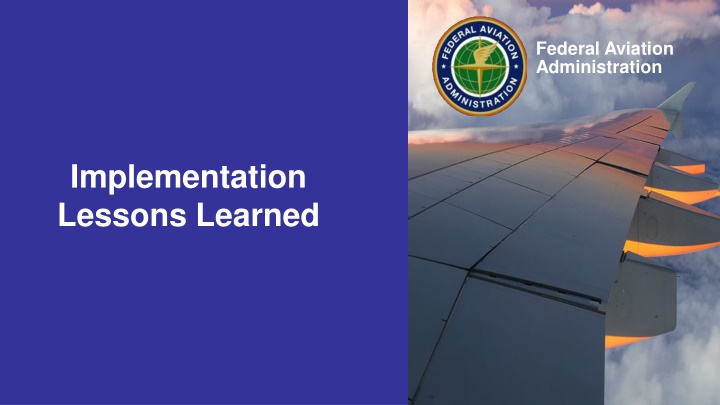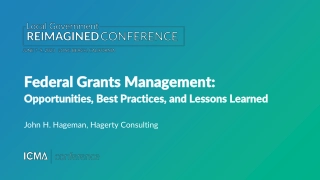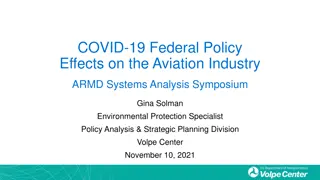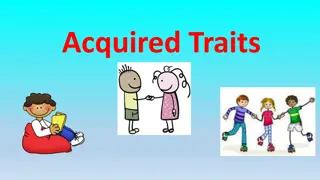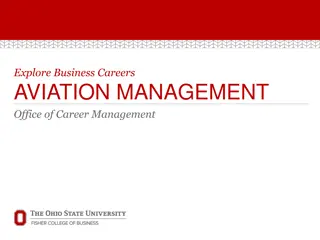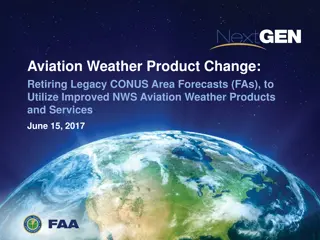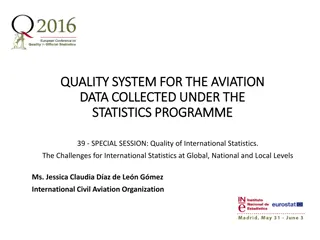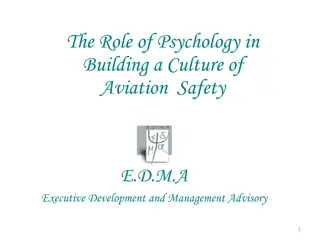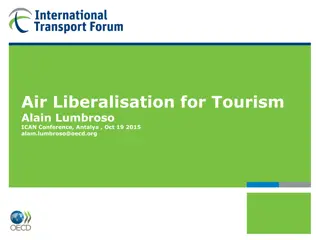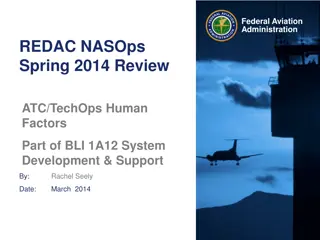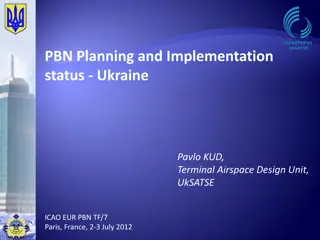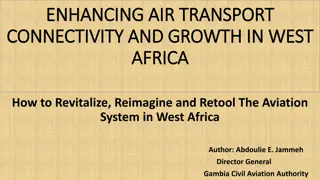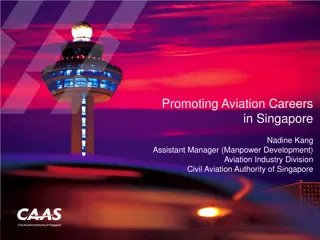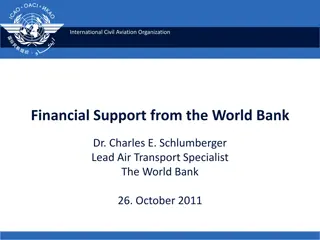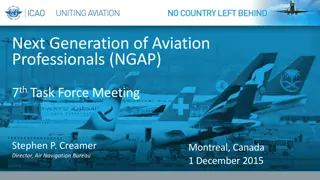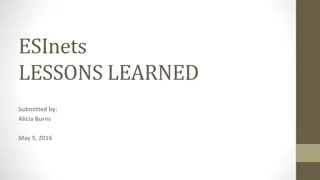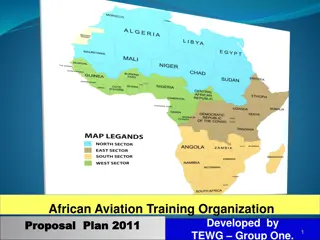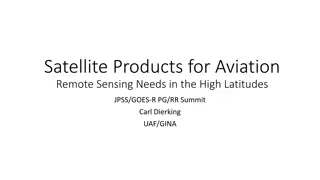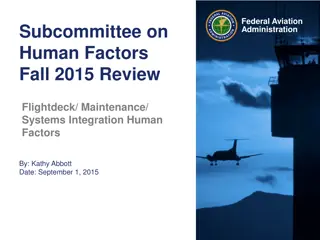Federal Aviation Administration Implementation Lessons Learned
This content provides valuable lessons learned in aviation implementation, focusing on understanding, awareness, and control of instructor mutations. It outlines the top 10 lessons learned in 2016 and 2018, covering topics such as math and psychology. Key takeaways include the definition of stall warning, considerations for thrust availability with altitude, and important principles regarding angle of attack and aerodynamic stall.
Download Presentation

Please find below an Image/Link to download the presentation.
The content on the website is provided AS IS for your information and personal use only. It may not be sold, licensed, or shared on other websites without obtaining consent from the author.If you encounter any issues during the download, it is possible that the publisher has removed the file from their server.
You are allowed to download the files provided on this website for personal or commercial use, subject to the condition that they are used lawfully. All files are the property of their respective owners.
The content on the website is provided AS IS for your information and personal use only. It may not be sold, licensed, or shared on other websites without obtaining consent from the author.
E N D
Presentation Transcript
Federal Aviation Federal Aviation Administration Administration Implementation Lessons Learned 1
Main points Need focus on trim understanding, awareness, and use Have to control instructor mutations Need the RIGHT attitude 2
Outline Top 10 lessons learned in 2016 Top 10 lessons learned in 2018 What we have learned in the last year? Some math Some psychology 3
Summary of lessons learned in 2016 #10 Stall warning has a definition; not AIRSPEED LOW 5
Summary of lessons learned in 2016 #10 Stall warning has a definition; not AIRSPEED LOW # 9 Thrust avail drops with altitude more than you think 6
Summary of lessons learned in 2016 #10 Stall warning has a definition; not AIRSPEED LOW # 9 Thrust avail drops with altitude more than you think # 8 It is fine to reduce AoA when banked 7
Summary of lessons learned in 2016 #10 Stall warning has a definition; not AIRSPEED LOW # 9 Thrust avail drops with altitude more than you think # 8 It is fine to reduce AoA when banked # 7 AoA is often still positive when you are upside down 8
Summary of lessons learned in 2016 #10 Stall warning has a definition; not AIRSPEED LOW # 9 Thrust avail drops with altitude more than you think # 8 It is fine to reduce AoA when banked # 7 AoA is often still positive when you are upside down # 6 Aerodynamic stall does not depend on speed, bank 9
Summary of lessons learned in 2016 #10 Stall warning has a definition; not AIRSPEED LOW # 9 Thrust avail drops with altitude more than you think # 8 It is fine to reduce AoA when banked # 7 AoA is often still positive when you are upside down # 6 Aerodynamic stall does not depend on speed, bank # 5 Wow, this airplane can really buffet 10
Summary of lessons learned in 2016 #10 Stall warning has a definition; not AIRSPEED LOW # 9 Thrust avail drops with altitude more than you think # 8 It is fine to reduce AoA when banked # 7 AoA is often still positive when you are upside down # 6 Aerodynamic stall does not depend on speed, bank # 5 Wow, this airplane can really buffet # 4 Many airplanes have little-to-no pitch break or rolloff 11
Summary of lessons learned in 2016 #10 Stall warning has a definition; not AIRSPEED LOW # 9 Thrust avail drops with altitude more than you think # 8 It is fine to reduce AoA when banked # 7 AoA is often still positive when you are upside down # 6 Aerodynamic stall does not depend on speed, bank # 5 Wow, this airplane can really buffet # 4 Many airplanes have little-to-no pitch break or rolloff # 3 Rudder in upsets is often hazardous and unpredictable 12
Summary of lessons learned in 2016 #10 Stall warning has a definition; not AIRSPEED LOW # 9 Thrust avail drops with altitude more than you think # 8 It is fine to reduce AoA when banked # 7 AoA is often still positive when you are upside down # 6 Aerodynamic stall does not depend on speed, bank # 5 Wow, this airplane can really buffet # 4 Many airplanes have little-to-no pitch break or rolloff # 3 Rudder in upsets is often hazardous and unpredictable # 2 The stall recovery template applies to all altitudes 13
Summary of lessons learned in 2016 #10 Stall warning has a definition; not AIRSPEED LOW # 9 Thrust avail drops with altitude more than you think # 8 It is fine to reduce AoA when banked # 7 AoA is often still positive when you are upside down # 6 Aerodynamic stall does not depend on speed, bank # 5 Wow, this airplane can really buffet # 4 Many airplanes have little-to-no pitch break or rolloff # 3 Rudder in upsets is often hazardous and unpredictable # 2 The stall recovery template applies to all altitudes # 1 Reducing angle of attack is the most important action 14
Summary of lessons learned in 2018 #10 Have stall warning sync issues in some types 16
Summary of lessons learned in 2018 #10 Have stall warning sync issues in some types # 9 Seeing good and bad bounce landing scenarios 17
Summary of lessons learned in 2018 #10 Have stall warning sync issues in some types # 9 Seeing good and bad bounce landing scenarios # 8 Push buttons still have their pros and cons 18
Summary of lessons learned in 2018 #10 Have stall warning sync issues in some types # 9 Seeing good and bad bounce landing scenarios # 8 Push buttons still have their pros and cons # 7 Some are trying to do too much in the first pass 19
Summary of lessons learned in 2018 #10 Have stall warning sync issues in some types # 9 Seeing good and bad bounce landing scenarios # 8 Push buttons still have their pros and cons # 7 Some are trying to do too much in the first pass # 6 Still have variations in OEM recovery techniques 20
Summary of lessons learned in 2018 #10 Have stall warning sync issues in some types # 9 Seeing good and bad bounce landing scenarios # 8 Push buttons still have their pros and cons # 7 Some are trying to do too much in the first pass # 6 Still have variations in OEM recovery techniques # 5 Taking a wait-and-see approach to sim maintenance 21
Summary of lessons learned in 2018 #10 Have stall warning sync issues in some types # 9 Seeing good and bad bounce landing scenarios # 8 Push buttons still have their pros and cons # 7 Some are trying to do too much in the first pass # 6 Still have variations in OEM recovery techniques # 5 Taking a wait-and-see approach to sim maintenance # 4 Some flying sim to the simulator limit perceived 22
Summary of lessons learned in 2018 #10 Have stall warning sync issues in some types # 9 Seeing good and bad bounce landing scenarios # 8 Push buttons still have their pros and cons # 7 Some are trying to do too much in the first pass # 6 Still have variations in OEM recovery techniques # 5 Taking a wait-and-see approach to sim maintenance # 4 Some flying sim to the simulator limit perceived # 3 Recovery targets can have unintended consequences 23
Summary of lessons learned in 2018 #10 Have stall warning sync issues in some types # 9 Seeing good and bad bounce landing scenarios # 8 Push buttons still have their pros and cons # 7 Some are trying to do too much in the first pass # 6 Still have variations in OEM recovery techniques # 5 Taking a wait-and-see approach to sim maintenance # 4 Some flying sim to the simulator limit perceived # 3 Recovery targets can have unintended consequences # 2 Some not mixing it up with VMC/IMC or day/night 24
Summary of lessons learned in 2018 #10 Have stall warning sync issues in some types # 9 Seeing good and bad bounce landing scenarios # 8 Push buttons still have their pros and cons # 7 Some are trying to do too much in the first pass # 6 Still have variations in OEM recovery techniques # 5 Taking a wait-and-see approach to sim maintenance # 4 Some flying sim to the simulator limit perceived # 3 Recovery targets can have unintended consequences # 2 Some not mixing it up with VMC/IMC or day/night # 1 The simulator is where we get everyone s attention 25
Summary of lessons learned in 2018 # 0 Some not respecting sim envelope limits 26
Summary of lessons learned in 2018 # 0 Some not respecting sim envelope limits # -1 Airbus motion-off recommendations does not meet reg, 27
Summary of lessons learned in 2018 # 0 Some not respecting sim envelope limits # -1 Airbus motion-off recommendations does not meet reg, # -2 Still seeing occasional use of pedals 28
Summary of lessons learned in 2018 # 0 Some not respecting sim envelope limits # -1 Airbus motion-off recommendations does not meet reg, # -2 Still seeing occasional use of pedals # -3 Recognize/confirm is often a forgotten first step 29
Summary of lessons learned in 2018 # 0 Some not respecting sim envelope limits # -1 Airbus motion-off recommendations does not meet reg, # -2 Still seeing occasional use of pedals # -3 Recognize/confirm is often a forgotten first step # -4 You should experience any force-feel changes 30
Summary of lessons learned in 2018 # 0 Some not respecting sim envelope limits # -1 Airbus motion-off recommendations does not meet reg, # -2 Still seeing occasional use of pedals # -3 Recognize/confirm is often a forgotten first step # -4 You should experience any force-feel changes # -5 The community is short on good surprise scenarios 31
Summary of lessons learned in 2018 # 0 Some not respecting sim envelope limits # -1 Airbus motion-off recommendations does not meet reg, # -2 Still seeing occasional use of pedals # -3 Recognize/confirm is often a forgotten first step # -4 You should experience any force-feel changes # -5 The community is short on good surprise scenarios # -6 Seeing too much push too often 32
Lessons learned in the last year #23 Still have untrained UPRT FAA inspectors 34
Lessons learned in the last year #23 Still have untrained UPRT FAA inspectors #22 Had challenges with operators flying less-common aircraft 35
Lessons learned in the last year #23 Still have untrained UPRT FAA inspectors #22 Had challenges with operators flying less-common aircraft #21 Wikipedia does not have a monopoly on knowledge 36
Lessons learned in the last year #23 Still have untrained UPRT FAA inspectors #22 Had challenges with operators flying less-common aircraft #21 Wikipedia does not have a monopoly on knowledge #20 ICAO has changed the definition of an upset; the FAA has not 37
Lessons learned in the last year #23 Still have untrained UPRT FAA inspectors #22 Had challenges with operators flying less-common aircraft #21 Wikipedia does not have a monopoly on knowledge #20 ICAO has changed the definition of an upset; the FAA has not #19 Not UPRT, but challenges arose on incorporating crosswind with gusts 38
Lessons learned in the last year #23 Still have untrained UPRT FAA inspectors #22 Had challenges with operators flying less-common aircraft #21 Wikipedia does not have a monopoly on knowledge #20 ICAO has changed the definition of an upset; the FAA has not #19 Not UPRT, but challenges arose on incorporating crosswind with gusts #18 Not a requirement for trainee to identify when to recover from full stall 39
Lessons learned in the last year #23 Still have untrained UPRT FAA inspectors #22 Had challenges with operators flying less-common aircraft #21 Wikipedia does not have a monopoly on knowledge #20 ICAO has changed the definition of an upset; the FAA has not #19 Not UPRT, but challenges arose on incorporating crosswind with gusts #18 Not a requirement for trainee to identify when to recover from full stall #17 Several V-n diagram rabbit holes 40
Lessons learned in the last year #23 Still have untrained UPRT FAA inspectors #22 Had challenges with operators flying less-common aircraft #21 Wikipedia does not have a monopoly on knowledge #20 ICAO has changed the definition of an upset; the FAA has not #19 Not UPRT, but challenges arose on incorporating crosswind with gusts #18 Not a requirement for trainee to identify when to recover from full stall #17 Several V-n diagram rabbit holes #16 Simulators, right now, not good at teaching somatogravic illusion 41
Lessons learned in the last year #23 Still have untrained UPRT FAA inspectors #22 Had challenges with operators flying less-common aircraft #21 Wikipedia does not have a monopoly on knowledge #20 ICAO has changed the definition of an upset; the FAA has not #19 Not UPRT, but challenges arose on incorporating crosswind with gusts #18 Not a requirement for trainee to identify when to recover from full stall #17 Several V-n diagram rabbit holes #16 Simulators, right now, not good at teaching somatogravic illusion #15 Airbus automated stall entry - a starting point, but not an ending point 42
Lessons learned in the last year #23 Still have untrained UPRT FAA inspectors #22 Had challenges with operators flying less-common aircraft #21 Wikipedia does not have a monopoly on knowledge #20 ICAO has changed the definition of an upset; the FAA has not #19 Not UPRT, but challenges arose on incorporating crosswind with gusts #18 Not a requirement for trainee to identify when to recover from full stall #17 Several V-n diagram rabbit holes #16 Simulators, right now, not good at teaching somatogravic illusion #15 Airbus automated stall entry - a starting point, but not an ending point #14 One operator starting, not ending, full-stall training with shaker de-activated 43
Lessons learned in the last year #23 Still have untrained UPRT FAA inspectors #22 Had challenges with operators flying less-common aircraft #21 Wikipedia does not have a monopoly on knowledge #20 ICAO has changed the definition of an upset; the FAA has not #19 Not UPRT, but challenges arose on incorporating crosswind with gusts #18 Not a requirement for trainee to identify when to recover from full stall #17 Several V-n diagram rabbit holes #16 Simulators, right now, not good at teaching somatogravic illusion #15 Airbus automated stall entry - a starting point, but not an ending point #14 One operator starting, not ending, full-stall training with shaker de-activated #13 For tailwind scenarios, it is all about timing on determining correct responses 44
Lessons learned in the last year #23 Still have untrained UPRT FAA inspectors #22 Had challenges with operators flying less-common aircraft #21 Wikipedia does not have a monopoly on knowledge #20 ICAO has changed the definition of an upset; the FAA has not #19 Not UPRT, but challenges arose on incorporating crosswind with gusts #18 Not a requirement for trainee to identify when to recover from full stall #17 Several V-n diagram rabbit holes #16 Simulators, right now, not good at teaching somatogravic illusion #15 Airbus automated stall entry - a starting point, but not an ending point #14 One operator starting, not ending, full-stall training with shaker de-activated #13 For tailwind scenarios, it is all about timing on determining correct responses #12 Some relying on FSB report for UPRT decisions 45
Lessons learned in the last year #23 Still have untrained UPRT FAA inspectors #22 Had challenges with operators flying less-common aircraft #21 Wikipedia does not have a monopoly on knowledge #20 ICAO has changed the definition of an upset; the FAA has not #19 Not UPRT, but challenges arose on incorporating crosswind with gusts #18 Not a requirement for trainee to identify when to recover from full stall #17 Several V-n diagram rabbit holes #16 Simulators, right now, not good at teaching somatogravic illusion #15 Airbus automated stall entry - a starting point, but not an ending point #14 One operator starting, not ending, full-stall training with shaker de-activated #13 For tailwind scenarios, it is all about timing on determining correct responses #12 Some relying on FSB report for UPRT decisions #11 Struggles with defining proficiency, namely in return to desired flightpath 46
Lessons learned in the last year # 10 Some not doing full stall training in all flight control modes 47
Lessons learned in the last year # 10 Some not doing full stall training in all flight control modes # 9 Many questions on best way to reduce pitch 48
Lessons learned in the last year # 10 Some not doing full stall training in all flight control modes # 9 Many questions on best way to reduce pitch # 8 Changed target speeds for slow flight in AC 120-111 (from Vref to Vmd) 49
Lessons learned in the last year # 10 Some not doing full stall training in all flight control modes # 9 Many questions on best way to reduce pitch # 8 Changed target speeds for slow flight in AC 120-111 (from Vref to Vmd) # 7 How can I find out the minimum drag speed? 50
